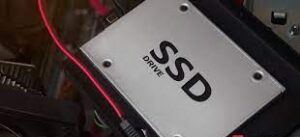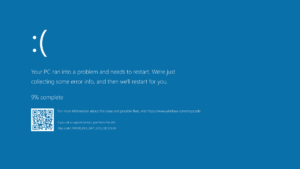Top warning signs of SSD failing will be described in this article. The lifespan of an SSD is affected by variables including its age, level of usage, kind of memory used, and operating circumstances. Although ideal circumstances can postpone failure, every drive will eventually fail.
As a result, it’s crucial to be aware of the warning signs provided by a failing SSD so that you may promptly backup all important data and replace the defective drive with the least amount of hassle.
By design, SSDs are significantly more resistant to vibration, stress, and other types of physical damage than HDDs, which have a lot of moving parts. Because there are no mechanical components, it is also ineffective to check for out-of-the-ordinary noises or other physical indications of failure.
It is preferable to check for software-end indicators, such as decreased performance, freezes, crashes, and other indications that we have covered in this post.
Warning signs of a Failing SSD
The first thing to hold in mind is that SSD failure progression varies greatly. Some SSDs experience a gradual performance slowdown, warning messages, and eventual conversion to read-only mode before totally failing, allowing the data to be recovered. Others might abruptly collapse with little to no notice.
As a result, it won’t always be feasible to spot the warning indications. You can take extra preparations for such situations, such as routinely monitoring the SSD’s state of health and regularly backing up your data, to make sure you’re always ready. After all of that, let’s discuss the most typical symptoms.
Top 6 Warning Signs to Know if Your SSD Is Failing In 2022
Top 6 Warning Signs to Know if Your SSD Is Failing are explained here.
1.Warning Notification

Despite the fact that this indicator only applies to NVMe SSDs running Windows and not SATA SSDs or HDDs, we’ll discuss it first because of how evident it is. Windows keeps an eye on the SSD for any hardware anomalies and issues a critical alert if any are found.
For instance, when the NVM subsystem experiences internal faults, the message “reliability is degraded” is often presented. Some cautions are a little simpler to understand, such “spare capacity is limited.” Also check software companies
In any case, if you do receive such alerts, we advise backing up your data and carefully examining your SSD’s condition to determine how much further the drive might endure. This is another sign of SSD Is Failing.
2.Degraded Performance
Failing read/write speeds are a reliable yet simple to miss sign of an SSD failure, especially early on. At start, you might occasionally notice such instances of subpar performance.
The performance hit will be seen more frequently until the SSD eventually stops functioning altogether. Extremely if the performance declines weren’t particularly obvious, this last death can seem abrupt. Therefore, backups are once again your buddy.
3. Freezes and Crashes

This is another sign of SSD Is Failing. You might have a bad SSD if you’ve noticed longer load times when running applications or if the software just stops or crashes outright. It’s challenging to make this diagnosis based just on this indicator because you may also have these problems owing to memory or internet connection problems. As a result, we advise checking for this indication in addition to the others in order to identify whether the SSD is the issue.
4.BSODs

When accessing specific apps or volumes, bad blocks on the SSD might cause data corruption, which manifests as a variety of errors. A Blue Screen of Death (BSOD), which can be caused by system file corruption, is a more severe instance of such problems.
If you’ve been experiencing BSODs lately, you might find our in-depth essay on the subject to be useful. You can establish whether the SSD is at fault by identifying the root cause of the specific bugcheck while troubleshooting the BSOD. This is another sign of SSD Is Failing.
5.Boot Errors
Some BSODs prohibit your computer from booting normally by keeping it in a crash loop. A failing SSD may also cause errors like No Bootable Device detected or the system hanging up during POST, in addition to the above problems.
6.Read-Only Drive
SSDs use flash memory blocks, which have a finite amount of write and erase cycles, to store data. Some SSDs will enter a failsafe mode as the memory ages, allowing you to at least read the data on the disc and restore it before the SSD entirely fails. It goes without saying that it would be advisable to backup the data on your SSD if it is now in a read-only mode because the drive may soon stop working altogether. Also check best websites for games cheat codes
Why Do SSDs Fail?
This is another sign of SSD Is Failing. There are a few SSD-specific problems that we’ll examine in this part, in addition to the apparent ones common to most storage medium, such broken hardware or file system corruption. You should be better able to grasp the causes of your SSD’s short lifespan as a result of these factors.
SSD Aged
The evidence from recent studies points to the device’s use age as the main element that impacts an SSD’s longevity, however this is still up for debate. This suggests that ageing processes like silicon ageing may be more important than the portion of data recorded.
The SSD controller must monitor a variety of things, including wear levelling, flash block pools, and encryption. All of this can build up over time and use. Alternately, problems with other components, such as the PCB and soldering, may also surface, ultimately resulting in the failure of the SSD controller.
The issue of employing SSDs for long-term storage, or archiving, is another one. SSDs use electrical charges to store information, which will slowly degrade over time if they are not powered. It is never a good idea to archive data and then forget about it, but doing so with SSDs is especially dangerous because you could lose your data later on.
Data Write Lifespan
As previously mentioned, the memory cells where the data is kept can only be erased and written to a certain number of times before they become worn out and useless. Because of this, an SSD’s lifespan can also be significantly impacted by usage intensity.
Chia mining, which includes continually assigning and freeing up space on the SSD, would be a severe example. Most SSDs die after a few months as a result of the constant and severe strain caused by this. Of course, this is just an extreme case, as SSDs aren’t typically used for crypto mining by people. This is another sign of SSD Is Failing.
Wear levelling would be a more pertinent issue for the typical user. The SSD may fail considerably sooner than you’d anticipate if a particular block of memory cells ages significantly more quickly than the others.
Through wear levelling, which involves the SSD controller distributing the writes across the flash blocks, modern SSDs counteract this. This makes sure that a certain block doesn’t fail too soon.
Wear levelling does have a drawback in that it necessitates periodic data relocation, which shortens the life of the data written. To enhance the drive’s longevity, manufacturers strive to strike a balance between the two sides.
We advise users to look up the TeraBytes Written (TBW) rate of their SSD. You can predict from this metric how greatly data can be reported to the SSD before it starts to likely start failing. Keep in mind that TBW is merely an estimation and not a promise of success.
Firmware Bugs
This is another sign of SSD Is Failing. In the past, one of the most frequent causes of SSD failing was due to firmware problems. The precise cause of failure would depend on the bug, but it would likely be something along the lines of defective firmware causing data corruption or a completely bricked SSD. These kind of firmware issues are less frequent now that they have generally been fixed, but they are still a concern.
Operating conditions
An abrupt loss of power was a common cause of data corruption and failure with earlier SSDs. This was due to the fact that if the power went off unexpectedly, the controller wouldn’t have enough time to update the mapping table and finish moving the data from the storage cache into the NAND flash (FTL). Recent types of SSDs almost never have this problem because they use Power Loss Protection features.
The operating temperature of an SSD has an effect on its failure rate as well. According to studies, SSD failure rates are higher while operating at temperatures exceeding 40 °C (104 °F). Manufacturers use techniques like thermal throttling and ship more expensive modules with built-in heat sinks to combat this.
How to Check SSD Health Status?
A failing SSD won’t always offer out obvious warning indicators, as we’ve already discussed. Therefore, it’s best to periodically manually check the SSD’s state of health. There are several ways to do this, but our suggested approach is to use the tool provided by the maker of your SSD (e.g., Samsung Magician Software). This is another sign of SSD Is Failing. Also check alternative Apps for ES File explorer
Can You Fix a Dead SSD?
Repositioning the SSD may be beneficial if your system suddenly stops detecting it. If reseating doesn’t work, it’s worth looking for damage in the other parts, such as the cables and ports. Another efficient remedy for recovering SSDs that are failing as a result of firmware difficulties is to upgrade the firmware.
But keep in mind that these are only broad solutions that have benefited some users. Try these if you believe your drive has already died. It would be advisable to take the SSD to a specialist for repair if you still had vital data on it when it stopped working.

